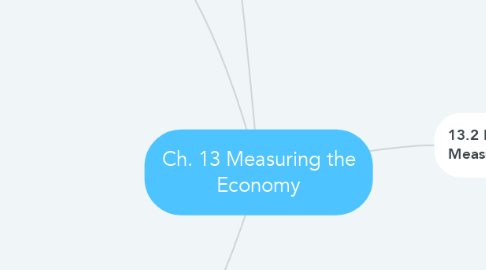Ch. 13 Measuring the Economy
by Mikayla Garman

1. 13.2 How do Economists Measure the size of an Economy?
1.1. Key Point 1: The main measure of the size of a nation's economy is through it's gross domestic product. (GDP)
1.2. Key Point 2: Economists calculate the GDP by dividing the economy into 4 parts, households, businesses, government and foreign trade. They then use this formula C+I+G+Nx=GDP
1.3. Key Point 3: GDP must take into account inflation. Nominal GDP measures in terms of today's dollar value, whereas real GDP measures the economy in terms of constant dollars.
1.4. Key Point 4: As a country's GDP increases, people within that country become better off. Country's with high GDP often have high literacy rates, higher life expectancy, and an overall better standard of living.
1.5. Terms: Gross domestic product- the market value of all final goods and services produced within a country during a given period of time. Per Capita GDP-a nation’s real GDP divided by its population; a measure of average economic output per person. Net exports- the value of all exports minus all imports
2. 13.3 What Does the Unemployment Rate Tell Us About an Economy’s Health?
2.1. Key Point 1: The unemployment rate is a useful indicator of the health of an economy. A high unemployment rate means the overall health of the economy is poor.
2.2. Key Point 2: Members of the labor force who have jobs are classified as employed whereas those who are jobless, but are looking for work, are classified as unemployed.
2.3. Key Point 3: There are four main types of unemployment. Frictional, structural, seasonal, and cyclical.
2.4. Key Point 4: Even when an economy reaches full employment, there will still be those without a job. When this happens economists call this the natural rate of unemployment.
2.5. Terms: Frictional unemployment-when workers are seeking their first job or have left one job and are seeking another. Structural unemployment- results when the demand for certain skills declines, often because of changes in technology or increased foreign competition; under such conditions, workers may need retraining to find new jobs Seasonal unemployment- occurs when businesses shut down or slow down for part of the year, often because of weather Cyclical unemployment-results from a period of decline in the business cycle; unemployment caused by a contraction
3. 13.4 What Does the Inflation Rate Reveal About an Economy’s Health?
3.1. Key Point 1: The inflation rate is the percent increase in goods and services from one month or year to the next. It is tracked by the Bureau of Labor Statistics.
3.2. Key Point 2: In an ideal world, prices would be stable and not raise or fall over time. The result of rising and falling prices leads to creeping inflation, hyperinflation, or deflation
3.3. Key Point 3: Inflation can be caused by many things including, an increase in money supply, increase in demand, and increases in the cost of the factors of production. All of these types of inflation can cause a wage-price spiral.
3.4. Key Point 4: Inflation comes with many economic costs. These can range from high interest rates, to loss of purchasing power, and loss of economic efficiency.
3.5. Terms: Inflation rate- the percentage increase in the average price level of goods and services from one month or year to the next Wage price spiral- an upward trend in wages and prices; a pattern in which rising prices lead to demands for higher wages, causing producers to raise prices further and workers to demand additional wage hikes
4. 13.5 How Does the Business Cycle Relate to Economic Health?
4.1. Key Point 1: The business cycle consists of four main phases. These phases include a period of growth and a period of decline, as well as the turning points that mark the shift from one period to the next.
4.2. Key Point 2: Business cycles are irregular in both length and severity. This makes peaks and troughs difficult to predict.
4.3. Key Point 3: Economists use many indicators to track the business cycle. These include leading indicators, coincident indicators, and lagging indicators
4.4. Key Point 4: A boom in the economy always turns to bust. The bust, or contract-ion phase of the business cycle, is also called a downturn, a downswing, or a recession
4.5. Terms: Depression-economic downturn characterized by plunging real GDP and extremely high unemployment


